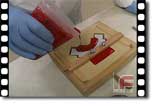Greetings!
Welcome to the February issue of Freeman's E-Newsletter!
In case you missed last month's announcement, our Miapoxy website is now live. missed last month's announcement, our Miapoxy website is now live.
We are working on a number of enhancements, including updated selection guides and expanded product offerings, which we will announce here when they are ready.
|
| Technical Spotlight |
|
 One of the most difficult tasks in planning and preparing for a tooling or mold-making project is calculating how much material you actually need. No one wants to buy more material than they need, nor do they want to run out of material in the middle of a project. One of the most difficult tasks in planning and preparing for a tooling or mold-making project is calculating how much material you actually need. No one wants to buy more material than they need, nor do they want to run out of material in the middle of a project.
This is why we incorporated the procedures for calculating your material requirements into our video on Weighing & Mixing Liquid Tooling Materials.
Also, we have a technical webpage devoted to the topic.
|
| Exclusive Videos
|
|
 As a subscriber, you have access to videos that aren't available anywhere else online. In fact, many new videos will be posted here before they are available via DVD. Just follow the links below. As a subscriber, you have access to videos that aren't available anywhere else online. In fact, many new videos will be posted here before they are available via DVD. Just follow the links below.
Available Now:
Coming Soon:
- Casting Molds & Models With Intricate Detail
- Silicone Rubber Molds with Complex Parting Lines
In Development: - Update to Basic & Advanced Vacuum Bagging Applications
- Vacuum Infusion Application
|
| Tech-Line Q & A |
|
 In every issue, we bring you the answers to real-world technical questions that have broad applications. Our technical support staff is available during normal business hours, Monday through Friday, by calling 800-321-8511 (Option 5) In every issue, we bring you the answers to real-world technical questions that have broad applications. Our technical support staff is available during normal business hours, Monday through Friday, by calling 800-321-8511 (Option 5)
How can I clean uncured resin from my urethane casting/ molds?
The following products can be used to clean the urethane casting and/or molds:
How can I clean uncured resin from my silicone molds?
- Clean off uncured material in mold with acetone
- Immediately wash with soap and water to remove the acetone before it attacks the silicone mold.
- Make one pour to pull off residuals.
- Apply a layer of silicone spray
How can I lower my cost when making a large room temperature model or master pattern?
Depending on the design of the model, lower density urethane foams, such as the RenShape 5020. 5025, or 5030, can be used as an undersized base. Then high density, hard, and better surface finish RenShape boards such as 450 or 460 may be glued on top for subsequent machining.
When I opened up my epoxy resin/hardener, it looks a little crusty and lumpy in texture. Will the material be acceptable to use if I just filter those chunks out before using the material.
The answer is no. The material is crystallized and should not be used until the entire can (chunks and all) has been completely liquefied again. The best way to bring a crystallized material back into a usable state is to heat the material to 120-140°F and then continue stirring it up periodically. You will soon notice the hard particles dissipating and the material becoming a homogenous liquid again.
At that point, the material is then suitable for use. Mix up a small batch of material after it has cooled from this process to test.
|